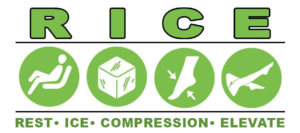Plantar Fasciitis can be a pesky foot problem, not to mention pretty painfully. It is crucial to the recovery process that you take care of your feet by wearing the proper shoes and orthotics but also attending to your foot health when you’re at home. Your time with Plantar Fasciitis may be cut short if you follow these 5 Tips to Treat Plantar Fasciitis at Home:
1. House Slippers

Step one is to never ever go barefoot. If you suffer from Plantar Fasciitis your plantar fascia is already weakened and stretched out. By walking around barefoot, especially on hard unnatural surfaces you are just continuing to stretch out and weaken the plantar fascia ligament, not allowing it to heal (potentially making your plantar fasciitis worse). House slippers with arch support are a great start to treating Plantar Fasciitis at home, it’s easy and for most people, we already wear slippers around the house. Now, you don’t want to wear just any slippers, you want to wear slippers that offer proper arch support so that they can align the foot and arch back to the proper position. When the arch is supported, the plantar fascia is supported which in return aids in elevating the pain in your heels. This is the first step to treating Plantar Fasciitis at home.
2. Feetures Plantar Fasciitis Relief Socks

The second step to treating Plantar Fasciitis at home is, wearing Plantar Fasciitis Relief Socks. These socks offer targeted compression technology which lifts, stretches, and stabilizes the plantar fascia and support the Achilles tendon. These can be worn at night while you are sleeping, so those first few steps in the morning are less excruciating. These socks can also be worn with everyday shoes especially if you are working out or sitting at a desk all day. It’s crucial to keep the Plantar Fascia supported at all times. The socks work to keep the arches compressed, which helps to release the tension of the plantar fascia. As an added bonus, they work as a sock and a healing mechanism for your plantar fascia!
3. Cool X Change Compress

The third step to treating Plantar Fasciitis at home is, wearing a cool compress around your foot. Compression is extremely beneficial to the arch. By compressing the arch you are alleviating pressure from the plantar fascia. If you want extra relief, you can use a cool compress, such as the Cool X Change Compress. This works as a compress for your feet but also has a cooling effect at the same time. The cooling effect from the Cool X Change helps to decrease inflammation that can be caused by Plantar Fasciitis. Think about it, you get two benefits out of just one item! This is the perfect item to use after a long day on your feet, and you can use it while you’re relaxing. Don’t skip this step and you’ll be on your way to pain-free feet in no time!
4. Stretching

The fourth step to treating Plantar Fasciitis at home is to stretch! Stretching is important to the recovery process when suffering from Plantar Fasciitis. Make use of the exercises to stretch the plantar fascia (and Achilles) that your physical therapist taught you. It’s free and you can do it while you’re watching tv, or before bed, and most importantly before getting out of bed in the morning. Stretching helps to relieve foot pain or chronic pain caused by Plantar Fasciitis, it is especially important to stretch first thing in the morning before getting out of bed, doing so, helps to relax and sooth the plantar fascia so that it lessens the pain of the first few steps you take in the morning. Wearing night splints while sleeping can help keep your foot stretched while you sleep so the pain is diminished in the morning. This can also prevent the shortening of the plantar fascia overnight while we sleep. This simple but important task is one part of a series of easy things to do at home to help heal from Plantar Fasciitis.
5. R.I.C.E Method

Our last piece of advice on how to treat plantar fasciitis at home is an old but gold one—the RICE Method. Not only is this a known method for the treatment of plantar fasciitis at home, it is also a renowned method for treating various common injuries like foot, ankle, and heel pain from heel bone spurs.
Rest
The R stands for Rest. Resting is one of the most common recommendations on how to treat plantar fasciitis and is extremely crucial to the recovery process. Now we all know, we don’t have very much time during the day to rest, but if you plan to recover, resting your feet as much as possible is the first key step to healing from Plantar Fasciitis or chronic plantar fasciitis. Resting decreases the stress of the plantar fascia and allows it to recover properly. So stay away from strenuous activity that may overstress your feet!
Ice
Ice, using ice decreases swelling and foot pain caused by Plantar Fasciitis. Do this 3 or more times a day in order to decrease inflammation. You can also try rolling a frozen water bottle under your feet while you rest!
Compress
Compressing or wrapping your injured foot can help to heal the plantar fascia faster, by allowing it to sit in a properly supported position. Compression will also decrease inflammation and swelling.
Elevate
By elevating your feet, you are keeping the area at or above the level of your heart, doing so helps to minimize swelling and discomfort in your feet.
Follow these steps to treating Plantar Fasciitis at home and you’ll be on your way to better healthier feet!

Jerick Sobie
Since 2005, I have been a dedicated small business owner specializing in footwear retail. With over 20 years of experience, my business partner and I have helped customers find the perfect shoes that combine style, comfort, and quality. Our expertise extends beyond local sourcing—we have traveled internationally to discover high-quality footwear that meets our customers’ needs. In addition to running my business, I have participated in numerous health fairs and educational seminars, sharing my knowledge on proper footwear and foot health. Committed to providing exceptional service, We carefully curate our selections to ensure the best fit and support for every customer.






















